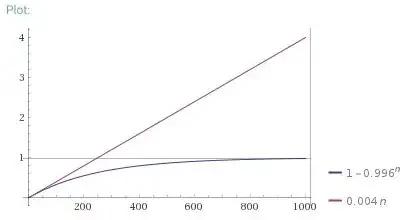To flesh out Mark Bennet’s answer with a little more detail, there are three questions here:
If a group of six people all try something they’ll succeed at one time in five, how often will at least one of them succeed?
If a group of six people all try something they’ll succeed at one time in five, a million times over, what is the expected number of successes?
As you know, the answer to question 1 is the chance that not all six will fail. $$1 - \left(\frac{4}{5}\right)^6 = \frac{11529}{15625} \approx 0.738$$
Question 2, you already answered: $\frac{1}{5} \cdot 6 \cdot 10^6 = 1.2 \cdot 10^6$. This is not only greater than 737,856, it’s greater than a million.
There’s no contradiction here. We can derive both from the probability of getting exactly one success on six attempts, two successes, and so on up to six.
What are those? Let’s say we have Alice, Bob, Clara, David, Emily and Frank. There’s exactly one success if Alice succeeds (1 time in 5) and each of the other five fails (4 times in 5, to the power of 5), or if the same happens to Bob, Clara, David, Emily or Frank.
There are exactly two successes if Alice and Bob succeed (1 time in 5, to the power of 2) and the other three fail (4 times in five, to the power of 3), and the same for any other pair of people: Alice and Clara, David and Emily, and so on. How many pairs of people are there? There are six people who could be first, and for each of them, five other people they could be paired with. Then, because picking Alice and David is the same as picking David and Alice, divide by two. As you probably know, this formula is written $\binom{6}{2}$ and pronounced “six choose two.” It’s equal to 15 (AB, AC, AD, AE, AF, BC, BD, BE, BF, CD, CE, CF, DE, DF, EF).
So, the odds of getting more than six or fewer than zero are nonexistent. Otherwise, the odds of getting exactly $i$ successes is $p(i) \equiv \binom{6}{i} \left( \frac{1}{5} \right)^i \left( \frac{4}{5} \right)^{6-i}$. That is, there are $\binom{6}{i}$ sets of $i$ people chosen from 6, a $\left( \frac{1}{5} \right)^i$ probability that all $i$ of them will succeed, and a $\left( \frac{4}{5} \right)^{6-i}$ probability that none of the remaining $6-i$ people will.
This allows us to compute the probabilities of every possible number of successes:
$
\begin{array}{ccccccc}
p(0) & p(1) & p(2) & p(3) & p(4) & p(5) & p(6) \\
\frac{4096}{15625} &\frac{6144}{15625} &\frac{768}{3125} &\frac{256}{3125} &\frac{48}{3125} &\frac{24}{15625} &\frac{1}{15625}
\end{array}
$
We can see that these probabilities add to 1. Furthermore, we can see that the probability that the number of successes is greater than 0 is equal to $1 - p(0)$. What is the expected number of successes? If we conducted a million random trials and counted the number of successes on each, we would add zero times the number of trials with no successes, plus one per the number of trials with exactly one success, two per the number of trials with exactly two successes, and so on up to six. The formula for the expected number of successes per round is therefore
$$ E = 0p(0) + 1p(1) + 2p(2) + ... + 6p(6) = \sum_{i=0}^6 i\cdot p(i) $$
Plugging in the numbers from our table, we see that this is
$$
0\frac{4096}{15625} + 1\frac{6144}{15625} + 2\frac{768}{3125} + 3\frac{256}{3125} + 4\frac{48}{3125} + 5\frac{24}{15625} + 6\frac{1}{15625} = \frac{6}{5}
$$
So, the expected number of successes per round of six people flipping coins is confirmed to be 1.2. On average, that’s 1.2 million successes per one million rounds.
If you’d like to learn more of what mathematicians have discovered about processes like this, you can search for Bernoulli distribution and geometric distribution.
